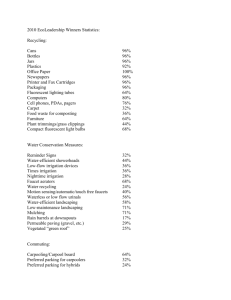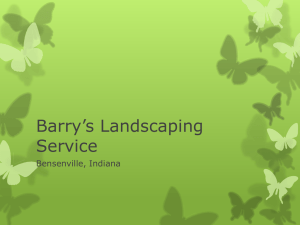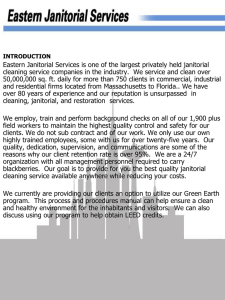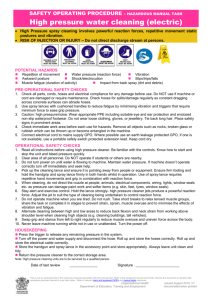Water use reduction guide
advertisement
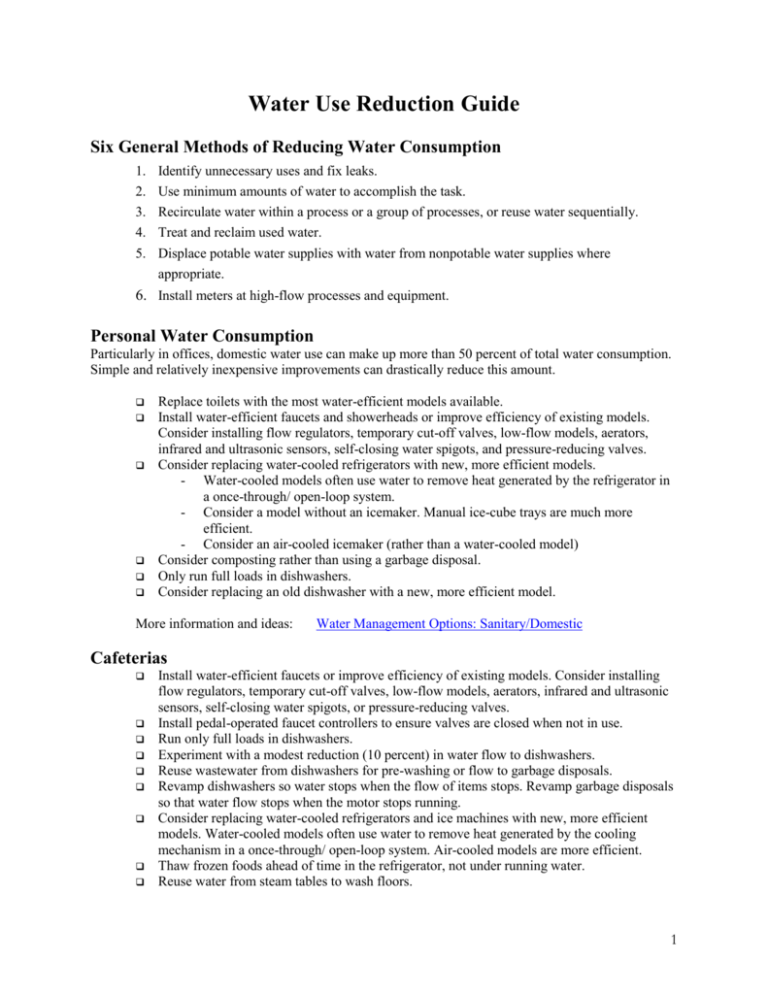
Water Use Reduction Guide Six General Methods of Reducing Water Consumption 1. 2. 3. 4. 5. Identify unnecessary uses and fix leaks. Use minimum amounts of water to accomplish the task. Recirculate water within a process or a group of processes, or reuse water sequentially. Treat and reclaim used water. Displace potable water supplies with water from nonpotable water supplies where appropriate. 6. Install meters at high-flow processes and equipment. Personal Water Consumption Particularly in offices, domestic water use can make up more than 50 percent of total water consumption. Simple and relatively inexpensive improvements can drastically reduce this amount. Replace toilets with the most water-efficient models available. Install water-efficient faucets and showerheads or improve efficiency of existing models. Consider installing flow regulators, temporary cut-off valves, low-flow models, aerators, infrared and ultrasonic sensors, self-closing water spigots, and pressure-reducing valves. Consider replacing water-cooled refrigerators with new, more efficient models. - Water-cooled models often use water to remove heat generated by the refrigerator in a once-through/ open-loop system. - Consider a model without an icemaker. Manual ice-cube trays are much more efficient. - Consider an air-cooled icemaker (rather than a water-cooled model) Consider composting rather than using a garbage disposal. Only run full loads in dishwashers. Consider replacing an old dishwasher with a new, more efficient model. More information and ideas: Water Management Options: Sanitary/Domestic Cafeterias Install water-efficient faucets or improve efficiency of existing models. Consider installing flow regulators, temporary cut-off valves, low-flow models, aerators, infrared and ultrasonic sensors, self-closing water spigots, or pressure-reducing valves. Install pedal-operated faucet controllers to ensure valves are closed when not in use. Run only full loads in dishwashers. Experiment with a modest reduction (10 percent) in water flow to dishwashers. Reuse wastewater from dishwashers for pre-washing or flow to garbage disposals. Revamp dishwashers so water stops when the flow of items stops. Revamp garbage disposals so that water flow stops when the motor stops running. Consider replacing water-cooled refrigerators and ice machines with new, more efficient models. Water-cooled models often use water to remove heat generated by the cooling mechanism in a once-through/ open-loop system. Air-cooled models are more efficient. Thaw frozen foods ahead of time in the refrigerator, not under running water. Reuse water from steam tables to wash floors. 1 Use brooms, squeegees or wet/dry vacs to clean the floor before washing. Do not use hoses as brooms. If sanitary regulations mandate hosing the floors, do so every other day and make sure hoses are equipped with high-pressure nozzles. If possible, wash linens half as often. Consider contracting to wash linens. More information and ideas: Water Management Options: Kitchen and Food Preparation Water Conservation Checklist: Food Service Operations Laboratory Consumption Install more efficient faucets. (Consider aerators, vacuum pumps rather than aspirators, pressurereducing valves, and automatic sensors). Replace old lab equipment with new, more efficient models. Revamp once-through cooling systems so that they are closed-loop. Consider reusing water where appropriate in lab processes. Consider recycling water from some lab machines into appropriate processes. Establish procedures for sampling, testing and clean up that minimize the amount of water required. Post these procedures and emphasize compliance. Mechanical Consumption Evaluate the necessity of water heaters and water softeners. If they are vital, do they always need to be running? For necessary water heaters and softeners, set backwash frequency to a lower setting (so that backwash occurs less often). Turn off ice machines when they are not needed. Consider replacing water-cooled drink machines with new, more efficient air-cooled models. Consider altering blow-down settings on boilers and cooling towers. (Are higher TDS allowances an option?) Heating, Ventilating and Air Conditioning (HVAC) Consumption If you have an evaporative/ indirect HVAC, consider replacing it with a more efficient model. If water is used, remodel so that water use is part of a closed-loop system. Consider setting office temperature higher in the summer, and lower in the winter. Turn HVAC off when no one is in the office. More information and ideas: Water Management Options: Cooling and Heating Cleaning Use Wash all vehicles as infrequently as possible without damaging equipment or compromising safety concerns. When vehicles must be washed, do so at a professional carwash where minimal waterconsumption machines are in use. Minimize the use of hoses as a cleaning tool; as an alternative, use dry-cleaning methods. (Sweep instead of hosing). If hoses are used, equip them with water-efficient, high-pressure nozzles. Wash office windows, building exteriors and sidewalks as infrequently as possible without damaging facility or compromising safety concerns. Establish cleaning procedures that minimize the amount of water required. Post these procedures and emphasize compliance. 2 More information and ideas: Water Management Options: Sanitary/Domestic Water Management Options: Cleaning & Rinsing Janitorial Use If possible, consider changes in janitorial procedures. Consult with janitorial staff or contracting agency to discuss water-efficient cleaning practices. Ensure that all staff are trained in the most water-efficient procedures. Include janitorial staff in your water conservation program. Be certain that janitorial staff are aware of all office water conservation efforts. Mop tiled areas as infrequently as possible without damaging facility or compromising safety concerns. Minimize the use of hoses as a cleaning tool. As an alternative, use dry-cleaning methods. (Sweep instead of hosing). If hoses are used, equip them with water-efficient, high-pressure nozzles. Establish cleaning procedures that minimize the amount of water required. Post these procedures and emphasize compliance. More information and ideas: Water Management Options: Sanitary/Domestic Water Management Options: Cleaning & Rinsing Landscaping Consumption Consider implementing xeriscape design. (Landscaping with mainly native and water-efficient vegetation.) Replace exotic plants with native species. Install efficient irrigation systems and regulate them carefully to avoid over-watering. Install rain gauges linked to your irrigation system to prevent irrigation when it is raining or has rained recently. Irrigate infrequently, and in the early morning or evening—when cooler air will minimize evaporation. If hoses are used, equip them with water-efficient, high-pressure nozzles. Minimize lawn/turf areas. Invest in soil improvements and mulch to retain moisture. Minimize water consumption by aesthetic pools and fountains. Replace aesthetic pools and fountains with other landscaping or structures. Remodel pools and fountains to become part of a closed-loop system. Consider using recycled water in pools and fountains. Invest in water meters dedicated to monitoring landscaping water use and check them regularly. (Become immediately aware of leaks in irrigation systems or hoses). Clean paved areas by sweeping them or blowing them free of debris, not by hosing. Include landscaping workers in your employee education program. Ensure that landscaping contractors are aware of your water conservation efforts More information and ideas: Water Conservation Checklist: Landscaping/Irrigation Maintenance Establish regularly scheduled plumbing checks to prevent leaks. Establish and communicate a ‘rapid response’ reporting system to quickly repair leaks and equipment malfunctions. 3 Establish regularly scheduled cleaning of auxiliary equipment. (Particularly heating and cooling systems; filters should be checked and replaced regularly.) Contractor Water Use Ensure that contractors are aware of your water conservation efforts. Ensure that contractors know where the water line is located. All too often, contractors accidentally drive heavy equipment over water lines, cracking the piping and causing expensive leakage and potentially dangerous ground saturation. 4
